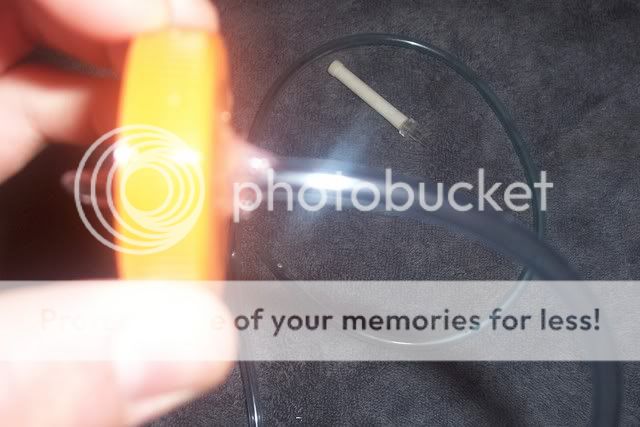taekwondoguy
Well-Known Member
First off I want to say I did NOT come up with this I just thought it might be something ya guys would appreciate and use to boost your yields.
DIY CO2 REACTOR
A CO2 reactor is an absolute MUST in a planted aquarium. The CO2 is dissolved in the water, where it is absorbed and used by the live plants.
~MATERIALS~
You will need:
1x Pair of small, pointed scissors. (Or a drill.)
1x Tube of Aquarium Safe Silicon. (Vinegar based)
1x Length of vinyl airline tubing. (I used about 3)
1x Air diffuser. (You can use an airstone, but they are less effective.
1x 32oz bottle. (I used a gatorade bottle, gotta love fruit punch)

You will also need a Check Valve. This prevents water from the tank from siphoning back into your CO2 mixture.

~STEP ONE~
Use your pointed scissors to "drill" out a hole in the center of the cap. You want the hole to be smaller than the airline tubing, but not by much.

~STEP TWO~
Cut your airline tubing at an angle. This will make it easier to fit in the cap.

~STEP THREE~
Insert your airline tubing into the cap from the top. If you need to, use a pair of pliers to pull it through. You only want it to stick through 1"-1.5".

~STEP FOUR~
Lay a small bead of silicon around the top, and bottom of the cap, where the airline tubing meets the plastic. Use a finger wet with rubbing alcohol to smooth out the bead. It doesnt have to be perfect, but the silicon is an extra precaution.

~STEP FIVE~
Screw your cap on the bottle. At this point, you want to wait 24-48 hours to cure. The longer the cure time, the better.

~STEP SIX~
Insert the plastic adapter from your air diffuser onto the free end of your airline tubing. Make sure it fits snug, so no air can escape.

~STEP SEVEN~
Attatch a small suction cup to the end of your airline. This is not necessary, but it helps to hold your airline in place in your aquarium, and I recommend using one.

~STEP EIGHT~
6-12" away from your bottle, cut your airline tubing. Insert your check valve into both ends. The arrow should be facing AWAY from your bottle, and TOWARDS your tank. This means your CO2 will go all the way through the line, but the water is prevented from siphoning into your CO2 mixture.

THE CO2 MIXTURE
For the mixture, you will need:
1/4x Teaspoon of Bakers Yeast.
1x Cup of Sugar. (granulated white)
1x Teaspoon of Baking Soda.
1x Access to hot and cold water.
~STEP ONE B~
Add your sugar and your baking soda to your bottle. Then fill up half way with HOT water. Shake the bottle violently to dissolve the sugar. It is helpful to have a cap that doesnt have a hole in it for the mixing purposes. I keep mine taped to the stand next to my bottle.
~STEP TWO B~
At this point in time, your sugar should have dissolved. Now, fill up the bottle until about 2" from the bottom of your airline tubing with COLD water. Shake for a bit to mix the water, to get the temperature even through-out.
~STEP THREE B~
Slowly add your 1/4 teaspoon of baking yeast. A few gentle shakes should mix the yeast in. Now put your cap back on.
~STEP FOUR B~
Placement of the air diffuser is important. I place mine next to the intake tube of my filter. The CO2 bubbles are sucked in by the impeller, and chopped up and made smaller. Many of the bubbles get stuck to the filter pad, were there are further dissolved into the water, for use by plants.
Notice the placement of my air diffuser, and its location in relation to the intake tube.

~FINAL PRODUCT~
If you do everything right, your aquarium plants should all be lush and green:

~HOW IT WORKS~
The sugar is used as a source of energy for the yeast culture. A by-product of this is the CO2. The baking soda is an additive to slow the reaction, to make the mixture last longer, and to regulate the reaction. If you have a low pH (6-6.5), you may need the increase surface agitation of a powerhead or other water pumps/filters to prevent CO2 poisoning, as your water can become CO2 saturated, which is bad for fish.
If you notice a large pH swing between the time your lights are on, and the time your lights are on, you should consider running an air-pump at night to prevent the CO2 buildup. When the lights turn off, the plants no-longer use CO2, but O2. All of the excess CO2 that isnt being used up will saturate your water, swing your pH, and kill your fish.
I am posting this on instructables as well, and I figured I could post it here as well. I know it doesnt involve fire, napalm, bombs, or any other RE cliche, but Im sure you non-aquarium savy hooligans can find something to do with it.
DIY CO2 REACTOR
A CO2 reactor is an absolute MUST in a planted aquarium. The CO2 is dissolved in the water, where it is absorbed and used by the live plants.
~MATERIALS~
You will need:
1x Pair of small, pointed scissors. (Or a drill.)
1x Tube of Aquarium Safe Silicon. (Vinegar based)
1x Length of vinyl airline tubing. (I used about 3)
1x Air diffuser. (You can use an airstone, but they are less effective.
1x 32oz bottle. (I used a gatorade bottle, gotta love fruit punch)

You will also need a Check Valve. This prevents water from the tank from siphoning back into your CO2 mixture.

~STEP ONE~
Use your pointed scissors to "drill" out a hole in the center of the cap. You want the hole to be smaller than the airline tubing, but not by much.

~STEP TWO~
Cut your airline tubing at an angle. This will make it easier to fit in the cap.

~STEP THREE~
Insert your airline tubing into the cap from the top. If you need to, use a pair of pliers to pull it through. You only want it to stick through 1"-1.5".

~STEP FOUR~
Lay a small bead of silicon around the top, and bottom of the cap, where the airline tubing meets the plastic. Use a finger wet with rubbing alcohol to smooth out the bead. It doesnt have to be perfect, but the silicon is an extra precaution.

~STEP FIVE~
Screw your cap on the bottle. At this point, you want to wait 24-48 hours to cure. The longer the cure time, the better.

~STEP SIX~
Insert the plastic adapter from your air diffuser onto the free end of your airline tubing. Make sure it fits snug, so no air can escape.

~STEP SEVEN~
Attatch a small suction cup to the end of your airline. This is not necessary, but it helps to hold your airline in place in your aquarium, and I recommend using one.

~STEP EIGHT~
6-12" away from your bottle, cut your airline tubing. Insert your check valve into both ends. The arrow should be facing AWAY from your bottle, and TOWARDS your tank. This means your CO2 will go all the way through the line, but the water is prevented from siphoning into your CO2 mixture.

THE CO2 MIXTURE
For the mixture, you will need:
1/4x Teaspoon of Bakers Yeast.
1x Cup of Sugar. (granulated white)
1x Teaspoon of Baking Soda.
1x Access to hot and cold water.
~STEP ONE B~
Add your sugar and your baking soda to your bottle. Then fill up half way with HOT water. Shake the bottle violently to dissolve the sugar. It is helpful to have a cap that doesnt have a hole in it for the mixing purposes. I keep mine taped to the stand next to my bottle.
~STEP TWO B~
At this point in time, your sugar should have dissolved. Now, fill up the bottle until about 2" from the bottom of your airline tubing with COLD water. Shake for a bit to mix the water, to get the temperature even through-out.
~STEP THREE B~
Slowly add your 1/4 teaspoon of baking yeast. A few gentle shakes should mix the yeast in. Now put your cap back on.
~STEP FOUR B~
Placement of the air diffuser is important. I place mine next to the intake tube of my filter. The CO2 bubbles are sucked in by the impeller, and chopped up and made smaller. Many of the bubbles get stuck to the filter pad, were there are further dissolved into the water, for use by plants.
Notice the placement of my air diffuser, and its location in relation to the intake tube.

~FINAL PRODUCT~
If you do everything right, your aquarium plants should all be lush and green:

~HOW IT WORKS~
The sugar is used as a source of energy for the yeast culture. A by-product of this is the CO2. The baking soda is an additive to slow the reaction, to make the mixture last longer, and to regulate the reaction. If you have a low pH (6-6.5), you may need the increase surface agitation of a powerhead or other water pumps/filters to prevent CO2 poisoning, as your water can become CO2 saturated, which is bad for fish.
If you notice a large pH swing between the time your lights are on, and the time your lights are on, you should consider running an air-pump at night to prevent the CO2 buildup. When the lights turn off, the plants no-longer use CO2, but O2. All of the excess CO2 that isnt being used up will saturate your water, swing your pH, and kill your fish.
I am posting this on instructables as well, and I figured I could post it here as well. I know it doesnt involve fire, napalm, bombs, or any other RE cliche, but Im sure you non-aquarium savy hooligans can find something to do with it.

